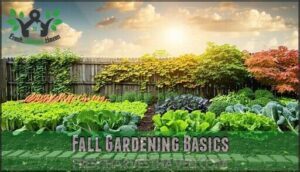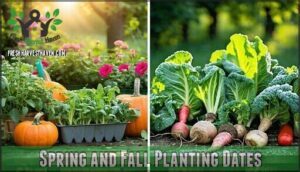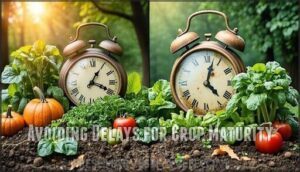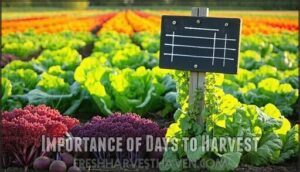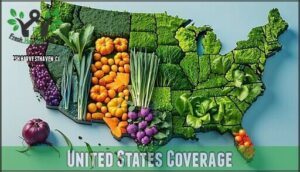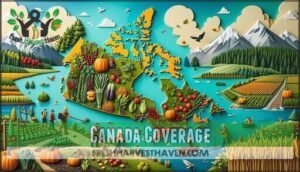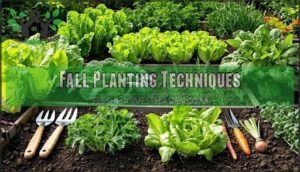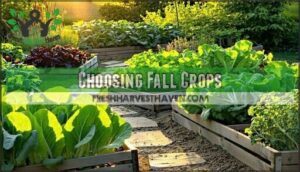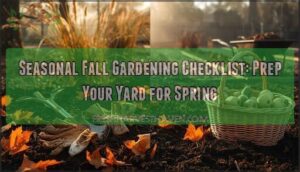This site is supported by our readers. We may earn a commission, at no cost to you, if you purchase through links.
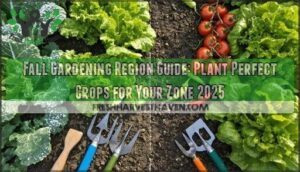
Zones 6-7 gardeners can plant until mid-September, while zones 8-10 enjoy extended growing seasons into October. Check your hardiness zone map first – it’s your roadmap to success.
Northern gardeners should focus on quick-maturing varieties, while southern zones can grow slower crops. Cold frames extend your season anywhere.
Each region has its sweet spot for timing, and getting it right means the difference between a thriving garden and disappointment.
Table Of Contents
- Key Takeaways
- Fall Gardening Basics
- Planting Calendar Guide
- Regional Planting Strategies
- Fall Planting Techniques
- Choosing Fall Crops
- Frequently Asked Questions (FAQs)
- When should you plant a garden in the fall?
- How do I plant a fall garden?
- How do you care for a fall garden?
- Is fall a good time for a garden?
- Can you plant vegetables in the fall?
- Is autumn a good time to plant a garden?
- How do I protect plants from unexpected early frost?
- What tools are essential for successful fall gardening?
- How often should I water fall vegetables?
- Can I save seeds from my fall harvest?
- Conclusion
Key Takeaways
- Know your hardiness zone and frost dates – You’ll need to check your USDA zone and local first frost date before planting, as this determines your 6-8 week planting window for fall crops to mature successfully.
- Time your planting strategically by region – If you’re in zones 3-5, plant by mid-August; zones 6-7 can plant until mid-September; and zones 8-10 can extend planting into October for optimal harvests.
- Choose cool-season and cold-hardy varieties – You’ll get the best results with crops like kale, spinach, lettuce, and radishes that actually taste sweeter after frost and can handle temperature drops.
- Use succession planting for continuous harvests – You can plant quick-growing crops like lettuce every two weeks to maximize your fall garden’s productivity and ensure fresh vegetables throughout the season.
Fall Gardening Basics
Fall gardening works best when you plant cool-season crops during the right window for your region, which typically means starting 6-8 weeks before your area’s first expected frost date.
Perfect fall timing means planting your cool-season crops exactly 6-8 weeks before that first frost hits your garden.
You’ll get stronger plants and better harvests because cooler temperatures reduce plant stress while warm soil still helps roots grow well.
Ideal Planting Times
Timing becomes your garden’s secret weapon when planning fall crops.
Your Frost Date Impact determines when tender plants must finish growing, while Maturity Period Adjustments help you count backward from that deadline.
Smart gardeners master these planting schedules to maximize harvests.
Key timing considerations for successful fall planting:
- Soil Temperature Matters – Wait for 70°F soil before seeding
- Regional Microclimates affect your specific planting dates substantially
- Planting Window Flexibility allows multiple succession plantings
Regional Guidance
Your location shapes everything about fall gardening success.
Climate considerations vary dramatically across North American gardening zones – what works in Florida won’t succeed in Minnesota.
Regional planting guides account for frost dates, soil temperatures, and maturity periods specific to your area.
Check your zone’s first frost date before selecting crops, as this determines your planting window for ideal harvests.
Understanding your USDA hardiness zone is essential for selecting plants that can survive the winter.
Plant Hardiness Zones
Your gardening zones act like a roadmap for successful fall planting. Zone mapping helps you understand which crops thrive in your specific climate, though microclimates impact growing conditions within each zone.
Gardening zones guide your fall planting journey, helping you choose crops that thrive while adapting to unique microclimates in your yard.
Climate change creates hardiness limitations that require zone adjustments for ideal results. Cool-season crops often taste sweeter after a light frost.
- Check your USDA zone for baseline planting dates
- Identify local microclimates in your yard
- Adjust for climate shifts affecting traditional zones
- Select zone-appropriate varieties for your regional gardening success
Planting Calendar Guide
You’ll find specific planting dates for both spring and fall seasons based on your exact zip code location.
These timing guides help you avoid planting delays that could prevent your crops from reaching maturity before the first frost hits your area, and thus ensure a successful harvest by following the exact timing guides.
Spring and Fall Planting Dates
Your local frost dates serve as gardening’s GPS, guiding spring planting after the last freeze and fall planting before winter arrives.
Regional microclimates can shift these dates by weeks, so check your zip code’s specific schedule.
Succession planting every two weeks maximizes harvests, while planting window extension techniques like row covers help you beat unpredictable weather patterns.
To optimize your planting schedule, consult The Old Farmer’s Almanac for precise dates.
Avoiding Delays for Crop Maturity
Plant your fall garden with purpose—every day counts toward successful crop maturity before winter’s first bite.
Regional microclimates and frost date impact determine your planting calendar’s success.
Delays mean stunted harvests or complete crop failure.
Succession planting every two weeks maximizes harvest extension while respecting maturity timeframes.
Your harvest timing depends on staying ahead of Mother Nature’s schedule to ensure a successful crop, which is crucial for successful crop maturity.
Importance of Days to Harvest
Reading seed packets reveals your garden’s timeline.
Days to maturity tells you exactly when crops reach harvest readiness from planting date.
Add fourteen extra days for slower fall growth.
Count backwards from your first frost date to determine planting windows.
Quick crops like lettuce mature in thirty days, while Brussels sprouts need ninety.
Proper harvest timing prevents frost damage.
Regional Planting Strategies
You’ll need different planting strategies based on where you live because climate zones across the United States and Canada vary greatly.
Your zip code determines the best planting dates, frost schedules, and crop varieties that’ll thrive in your specific region’s growing conditions.
United States Coverage
Understanding USA gardening zones makes the difference between harvest success and disappointment.
Your state’s specific frost dates and regional microclimates determine when you’ll plant fall crops and what varieties thrive best.
- Northern states (Zones 3-5) need cold-hardy varieties planted by mid-August
- Central regions (Zones 6-7) offer flexible planting windows through early September
- Southern areas (Zones 8-10) extend fall gardening into October with heat-tolerant selections
Canada Coverage
Canada’s regional climates span eight hardiness zones, from coastal British Columbia to northern territories.
Your frost dates determine planting schedules for fall gardening success. Southern regions enjoy longer growing windows, while prairie provinces face earlier freezes.
Proper soil preparation and crop selection matter most in Canada’s diverse zones. Cold-hardy vegetables thrive when you match varieties to your specific location.
Adapting to Diverse Climates
Success in fall planting hinges on mastering your local microclimate management and understanding regional soil variations.
Your zone-specific planting schedule must account for elevation, proximity to water, and urban heat islands that create pockets of different growing conditions.
Implement frost protection strategies like row covers while practicing water conservation techniques.
Climate-specific gardening means adapting proven methods to your unique regional climate conditions.
Fall Planting Techniques
You’ll need the right techniques to make your fall garden successful in your specific region.
Proper soil preparation, smart container choices, and selecting bolt-resistant varieties will help your crops thrive before winter arrives.
Container Gardening
Container gardening offers flexibility for your autumn garden.
You can easily move pots indoors when temperatures drop, protecting tender plants from frost.
Patio gardening and balcony containers work perfectly for cool season crops like lettuce and herbs.
Try vertical gardens to maximize space, and choose dwarf varieties that thrive in smaller containers during fall planting season.
Consider selecting stylish containers for aesthetic appeal.
Soil Preparation Techniques
Before planting your fall garden, you’ll need to prep your soil like a chef preparing ingredients.
Remove summer crop remnants and pull existing weeds completely. Mix in 2-3 inches of compost to boost soil quality and add organic matter.
Consider buying soil products to further enrich your garden.
Test your soil pH, aiming for a 6.0-7.0 range.
Apply mulch around plants for temperature regulation and moisture retention.
Adjusting Varieties for Bolt Resistance
After prepping your soil, you’ll want smart variety selection to extend harvest windows.
Choose bolt-resistant varieties that won’t rush to seed when temperatures fluctuate.
Heat-tolerant strains like slow-bolt lettuce and cold-hardy spinach give you flexibility during unpredictable fall weather.
These improved cultivars handle temperature swings better than standard varieties, preventing premature bolting and keeping your fall planting productive longer.
Choosing Fall Crops
You’ll want to pick vegetables that can handle cooler weather and shorter days when planning your fall garden.
Focus on cold-hardy crops like kale, spinach, and radishes that actually taste better after a light frost, plus quick-growing options like lettuce that you can plant every two weeks for fresh harvests all season long.
Cool-Season Crops
Cool-season crops thrive in fall’s crisp temperatures, making them perfect for your autumn vegetable gardening adventure.
These champions of the brassica family and root vegetables actually prefer cooler weather over summer’s heat. You’ll discover that hardy greens like lettuce, spinach, and kale grow vigorously when temperatures drop.
Fall planting rewards you with frost-sweetened harvests that taste incredible. Gardeners can find fall planting seeds for a successful crop, allowing them to enjoy the benefits of autumn vegetable gardening.
Cold-Hardy Vegetables
While cool-season crops handle chilly weather, cold-hardy vegetables are your frost warriors.
These champions like kale, Brussels sprouts, and spinach laugh at light freezes.
They actually get sweeter after frost touches them – nature’s way of making frost-sweetened harvests.
Mulch provides insulation and stabilizes the soil temperature.
Plant them 6-8 weeks before your first frost date for best cold tolerance levels and winter vegetable care success.
Quick-Growing Crops for Continuous Yield
For a continuous harvest of autumn crops, try succession planting with quick-growing vegetables like lettuce or radishes.
Stagger plantings every two weeks to optimize space and guarantee frequent harvesting. Choose bolt-resistant varieties for lettuce cultivation in warmer fall planting conditions.
Consider exploring options for fall crop products to enhance your gardening efforts.
Cool-season crops like spinach thrive in shorter days, offering fast yields while maximizing your garden’s potential for abundant, fresh produce.
Frequently Asked Questions (FAQs)
When should you plant a garden in the fall?
Sarah started her fall carrots in August and harvested sweet, crisp roots in November.
You should plant fall gardens 6-8 weeks before your first frost date, typically mid-to-late summer for the best harvest.
How do I plant a fall garden?
Start by removing summer crop debris and weeds.
Add 2-3 inches of compost to your soil.
Plant cool-season crops like lettuce, kale, and radishes 6-8 weeks before your first expected frost date.
How do you care for a fall garden?
Crisp autumn air signals it’s time to nurture your cool-season crops.
Water deeply but less frequently, mulch around plants for insulation, and harvest regularly to encourage continued growth through the season.
Is fall a good time for a garden?
Fall’s actually perfect for gardening!
You’ll face fewer pests, enjoy cooler temperatures, and watch cool-season crops like kale and spinach thrive.
Plus, autumn’s consistent rainfall means less watering work for you.
Can you plant vegetables in the fall?
Like ancient farmers storing grain for winter, you can plant cool-season vegetables in fall.
Choose kale, spinach, lettuce, and radishes.
Plant 6-8 weeks before your first frost date for best results.
Is autumn a good time to plant a garden?
Yes, autumn’s perfect for planting cool-season vegetables like kale, spinach, and garlic.
You’ll enjoy fewer pests, natural rainfall, and sweeter flavors after frost.
Plant 6-8 weeks before your first expected freeze date.
How do I protect plants from unexpected early frost?
Cover plants with old sheets, blankets, or row covers when frost threatens. Water soil beforehand since moist soil retains heat better. Move containers indoors temporarily, and harvest tender crops immediately.
What tools are essential for successful fall gardening?
Essential tools make fall gardening smooth and successful.
You’ll need a quality spade for planting, hand pruners for harvesting, row covers for frost protection, and a soil thermometer to monitor planting conditions perfectly.
How often should I water fall vegetables?
Water fall vegetables deeply once or twice weekly, adjusting for rainfall and soil moisture.
Check soil by inserting your finger two inches deep—if it’s dry, it’s time to water your garden.
Can I save seeds from my fall harvest?
Like squirrels gathering nuts for winter, you can harvest seeds from mature fall vegetables.
Choose fully ripened fruits and vegetables, dry seeds thoroughly, then store them in cool, dry places for next season’s planting adventures, and remember to handle them with care for successful harvest.
Conclusion
Success in fall gardening isn’t just luck—it’s proven science backed by climate data.
Your fall gardening region guide becomes your blueprint for timing perfect harvests before winter arrives.
You’ve learned when to plant, which crops thrive in your zone, and how to extend seasons with smart techniques.
Now you’re equipped to transform those empty summer beds into productive fall gardens.
Start planning today, because your zone’s ideal planting window won’t wait for perfect weather conditions.
- https://www.almanac.com/gardening/frostdates
- https://agrilifeextension.tamu.edu/library/gardening/carrots/
- https://gardensuperstore.com.au/insights/the-right-crop-the-right-time-seasonal-planting-for-garden-success/?srsltid=AfmBOooXdEKBEoPXqgYArOlt2dAZhD0qLuVYhUIwX_3vKi2CCfvPb3Jq
- https://www.farmraise.com/blog/a-farmers-guide-to-surviving-planting-season
- https://articles.avarchitectsbuild.com/how-to-grow-vegetables-at-home-northern-virginia

